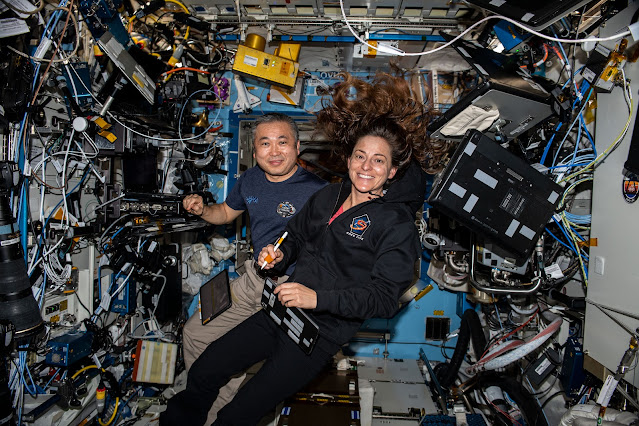Download Free NASA Commercial Crew 2023 Children's Artwork Calendar
Download Free Adobe PDF 2023 CCP Children's Artwork Calendar (2.5MB) here (English):
https://www.nasa.gov/sites/default/files/atoms/files/ksc_2023_ccp_childrens_artwork_calendar_508.pdf
Congratulations to this year’s winners of the 2023 Commercial Crew Program (CCP) Children’s Artwork Contest!
The contest—designed to get our youth excited about science, technology, engineering and math and to inspire our future scientists, engineers and explorers—ran from Sept. 2 through Oct. 27. The contest asked young artists ages 4-12 years old to submit unique and original masterpieces featuring NASA themes: Rockets and Spacecraft, Living and Working in Space, Exploring the Solar System, and Astronauts.
Kids from all over the world submitted 2,260 entries, which were judged on originality and composition. A total of 36 entrants were selected first, second, or third place winners in each theme and age category.
Thank you to all our incredible artists! NASA’s Commercial Crew Program is working hard to make living and working in space safe and affordable for people all around the world. When you grow up, there could be many different spacecraft taking scientists, researchers, educators, and even tourists to different low-Earth orbit destinations like space stations, laboratories, and hotels! The science NASA’s Commercial Crew Program helps enable in space is making life better here on Earth and helping explorers go back to the Moon and on to Mars.
2023 CCP Children's Artwork Calendar
Category: Rockets and Spacecraft
Ages 4 to 6
1st - SpaceX Dragon Crew-5, Kaushik, I., USA
2nd - NASA Rocket Launch Day, Kim, T., South Korea
3rd - Rockets and Spacecraft, J, Achyutkemparaj, India
KSC 2023 CCP Childrens Artwork Calendar Cover
Ages 7 to 9
1st - Artemis from the Moon to Mars, Costa, L., USA
2nd - Hello Future!, Yoo, J., South Korea
3rd - NASA & Galaxy, Yeo, S., USA
Ages 10 to 12
1st - A Long Flight to Mars, Zhang, X., USA / China
2nd - Rocket to Freedom, Wynar, M., USA
3rd - Working in Space, Lee, J., China / South Korea
Category: Exploring the Solar System
Ages 4 to 6
1st - Reach for the Stars, Chandra, A., USA
2nd - Dancing with Planets, Jung, Y., South Korea
3rd - They are Smiling at Me, Zhou, C., USA
Ages 7 to 9
1st - Exploring the Solar System, Chavala, H., USA / India
2nd - Out in Space, Kimmel, G., USA
3rd - My Happy Space, Sidharth, S., India
Ages 10 to 12
1st - Puzzled Solar System, Thomas, E., USA
2nd - Each Planet has its Purpose , Lee, S., South Korea
3rd - Space Exploration of our Dreams, Yun, H., South Korea
KSC 2023 CCP Childrens Artwork Calendar Back Cover
Category: Living and Working in Space
Ages 4 to 6
1st - Dance my Dream in the Space, Zhou, E., USA
2nd - Art in Space, Yu, A., USA
3rd - Growing up in Space, Hui, M., Canada
Ages 7 to 9
1st - Atmosphere for Life, Usman Adnan Sheikh, M., Pakistan
2nd - Astronaut's Yummy Breakfast in Space, Niu, J., USA / China
3rd - IMAGI-SPACE, Christopher, N., India
Ages 10 to 12
1st - Living and Working in Space, Reddy, M., India
2nd - Daily Life in Space, Lee, M., USA
3rd - Jewelry Making Process in Space, Lee, S., South Korea
Category: Astronauts
Ages 4 to 6
1st - The Colors of the Life, Maity, A., UAE / India
2nd - Hello Astronauts, Fung, T., USA
3rd - Astronauts: Enjoying Coffee Time in Space, Mohapatra, A., India
Ages 7 to 9
1st - Astronaut on the Moon, Gleason, A., USA
2nd - World Peace on the Moon, Kim, S., USA / South Korea
3rd - Space…Playground of the Astronauts!, Rahman, A., India
Ages 10 to 12
1st - Exploring the Vast Beyond, Appou, G., USA
2nd - Me as Astronauts, Thiththika, A., India
3rd - Outer Space, Tong, S., USA
Credit: Commercial Crew Program, Kennedy Space Center (KSC)
Thank you to SciArt Exchange for helping NASA conduct this year’s contest.
#NASA #Astronomy #Space #Science #ISS #CommercialCrewProgram #SpaceX #CrewDragon #Boeing #Starliner #Calendar2023 #Calendar #Children #Youth #Artwork #World #Global #Contest #FreeDownload #AdobePDF #Astronauts #Earth #Moon #Planets #Mars #SolarSystem #Rockets #Spacecraft #Exploration #Learning #KSC #UnitedStates #International #STEM #Education
























NASA-JSC.jpg)



















